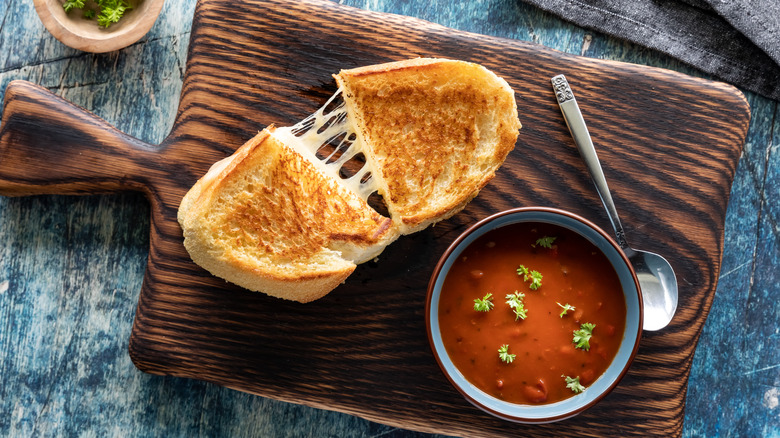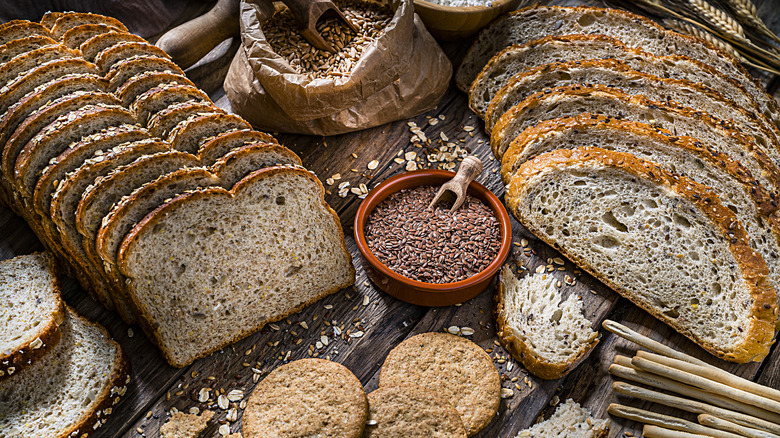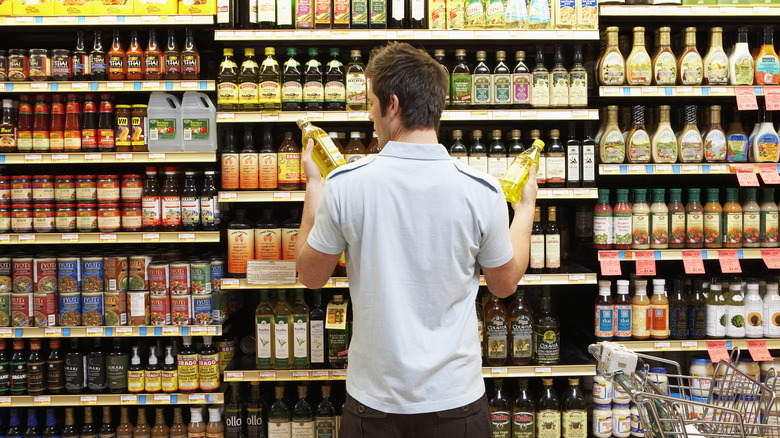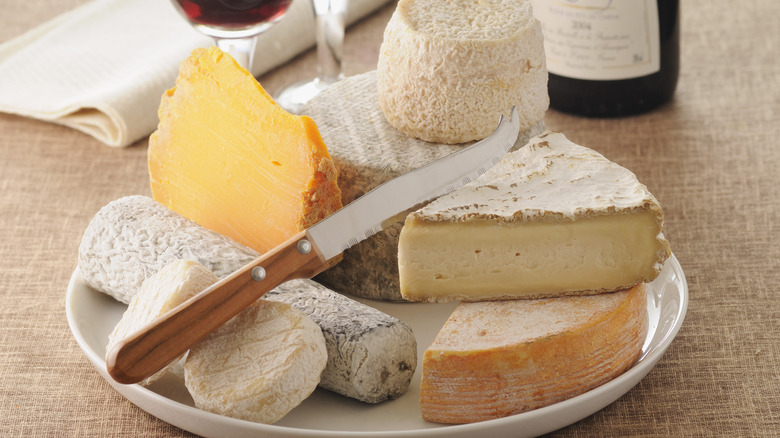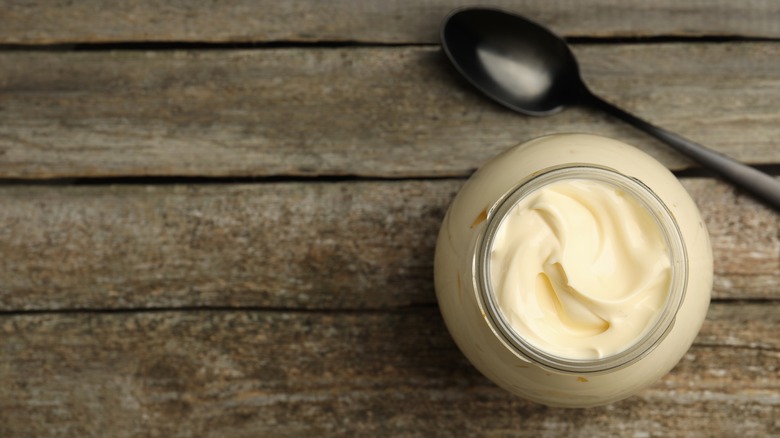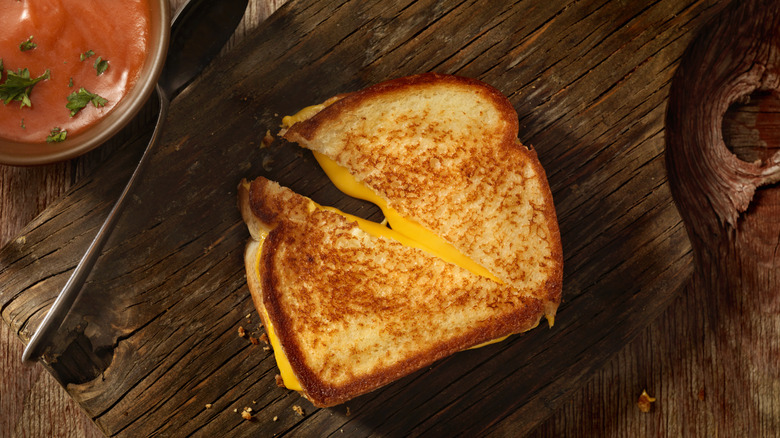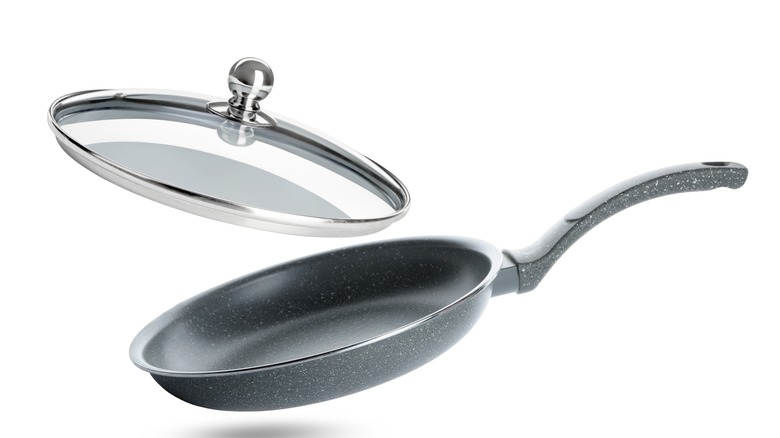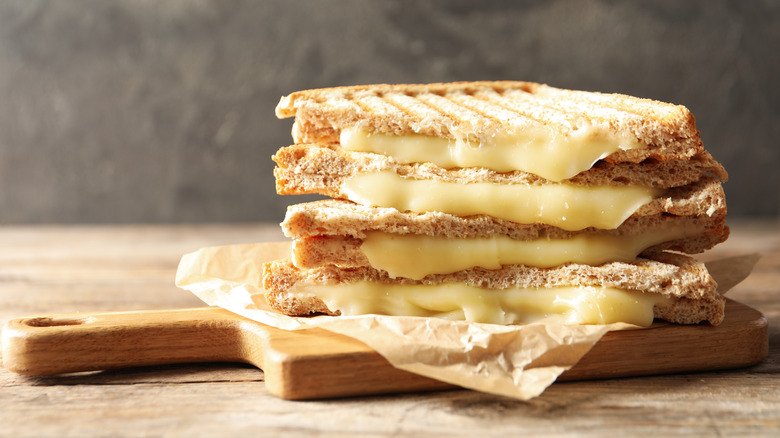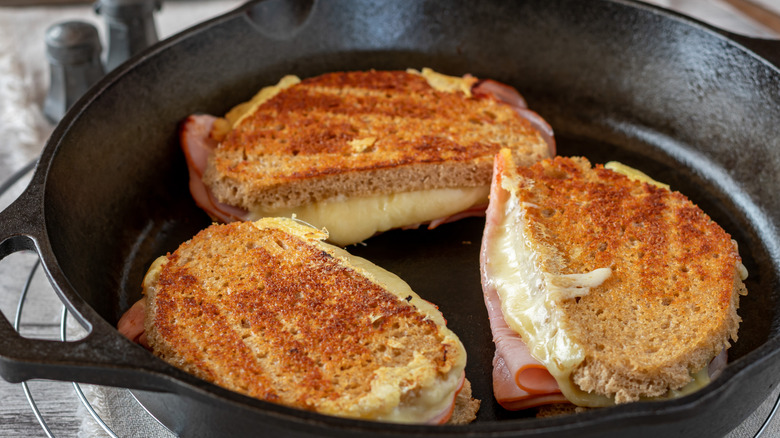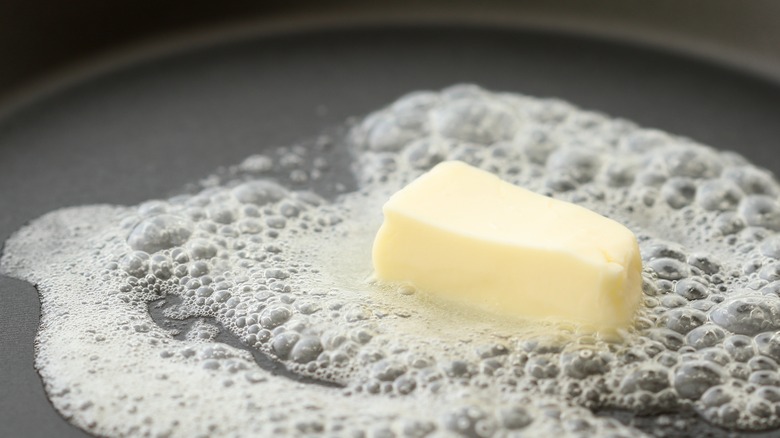9 Tips For The Crispiest Grilled Cheese You've Ever Had
Few dishes are as quintessentially American as the classic grilled cheese. Loved by kids and adults equally, the comforting feeling you get when dipping a crusty sandwich into tomato soup is unparalleled, even by the most fancy dishes. While no one knows the exact date the first grilled cheese was born, it's believed to have been created around the 1920s and '30s during the Depression era when processed cheeses still remained low in cost. Even though it was cheap, it was still delicious, and it has remained popular ever since. Even today, during times of shrinkflation at the grocery store, the grilled cheese is relied upon.
While the sandwich "recipe" is as basic as it can get in theory — bread plus cheese griddled in a pan until toasty — there are actually a few techniques that can be learned and utilized for making the best, crispiest grilled cheese sandwiches. From choosing the right bread to the right pan, we've got you covered. Let's get into it.
Choose the right bread
White sandwich bread is fine, but brioche is even better. What about a croissant loaf for an avant-garde grilled cheese? When choosing bread, don't go for the squishiest, softest loaf on the shelf. Look for something firmer rather than squishy and soft so that the sandwich will be sturdy enough to flip and press and stay together. Homemade sourdough can be great for grilled cheeses, and the golden brown crust on the bread will crisp up even further during the cooking process. If you need a gluten-free option, most loaves will work pretty decently as long as they're a sliced sandwich bread.
Breads to avoid are those without an exposed interior crumb; like burger buns, ciabatta, focaccia, and others that aren't traditionally sliced for sandwiches. Instead of crisping up the interior, the exterior often is the only part to toast, and the sandwich doesn't reach peak crispiness. Breads like these work better for sandwiches like classic tuna melts.
Use the right cooking oil
When making grilled cheese, low and slow cooking is usually the name of the game. Use canola oil, grapeseed, or another oil with a high smoke point since the sandwich will be over the heat for a long time, and we'd like to avoid smoking up the kitchen. While butter is often used for grilled cheeses, the milk solids contained in it can brown and burn way faster than other oils with higher smoke points. While butter can start smoking around 300 degrees Fahrenheit, canola oil can be heated up further to 400 degrees any without problems.
While olive oil, especially extra virgin, can have a smoke point of around 350 degrees, this is typically not going to be a problem when making grilled cheeses on low to medium heat. When all else fails and the kitchen happens to get smoky, just turn off the heat, remove the grilled cheese from the pan, and wait for things to cool down a bit.
Use the best cheese (and the right amount)
Classically, American cheese is the go-to for its melty nature and mild flavor. But not only are those qualities working in its favor, it's also a cheese that doesn't contain a lot of moisture. More moisture means less crisping, especially in a grilled cheese, which is another reason American cheese excels here. If you don't like processed cheese so much, there are plenty more options to choose from.
The first thing you should do when choosing what to fill your grilled cheese with is think about the how well the cheese melts. There are pros and cons of melting cheeses; some are better suited for sandwiches, like mozzarella, provolone, and Gruyère. These would all be great options for cheeses that melt enough to glue bread together. While Parmesan, pecorino, and other drier cheeses don't melt as well, you can still mix some of these aged cheeses with ones that melt better to create your perfect blend.
Try using mayonnaise
A widely known grilled cheese "secret" is to use mayonnaise on the outside of the bread instead of butter. Why? Because it contains oil, which helps with sticking, and egg, which helps with browning. With mayonnaise, the two are permanently bound together. Simply using egg and oil on a regular piece of bread wouldn't work at all, so the condiment is actually quite useful. A vegan mayonnaise should work just as well, in theory. Butter, as we mentioned before, will start to burn and smoke way before mayonnaise will, since there are no milk solids in the mayo jar.
Instead of buttering the outside of your bread, simply replace it with a generous layer of mayonnaise. The resulting sandwich will crisp up to golden brown perfection and it won't even taste like it's been soaking in mayo — but if you want a little mayo flavor, no harm, no foul. Just spread some extra on the interior of the sandwich bread as well. While we're on the topic of condiments, it also wouldn't hurt to upgrade your grilled cheese with a little mustard. It pairs excellently with cheese!
Cook it low and slow
Low and slow is always the best way to go for a perfectly cooked grilled cheese. If the heat is too high, the bread will burn on the outside even before it's toasted, and the cheese won't be melted, either. Let's avoid that. While a cast iron pan could work well for this low and slow method, try using a non-stick for your first go around, as it's easier to lower and raise the heat level on the fly.
Preheat your pan on low heat while you build your grilled cheese. Place the sandwich in the pan and let it cook for 5 minutes or until it's golden brown. If it's not browned enough, continue for another 2-3 minutes. Flip and press down lightly, then repeat the same process of letting it toast slowly without moving. This gives the bread enough time to toast up and melts the cheese nice and evenly for the perfect sandwich.
Try cooking with the lid on
Consider how a frying pan or skillet cooks: Heat emanates from the bottom of the pan on the stovetop burner and then distributes throughout the rest of the pan. Since there's no lid when you usually make a grilled cheese, the heat just continues rising and dissipates into the air above. But if you add a lid to the pan, you can trap the extra heat and use it to your advantage.
When you close the lid, the heat build-up begins to steam and melt your cheese more evenly. If you're using a thin bread that doesn't need much toasting, or you want to cook things a little faster, this is the perfect trick for moving things along. Build your sandwich, pop it in the pan, and let it cook with the lid on (still in the low to medium heat range) for a good 5 minutes. Remove the lid, flip, and cook as normal. While this doesn't crisp your sandwich faster, it does help it cook more quickly and makes it prime for flattening into a thin and crunchy grilled cheese.
Add some weight to press it down
Take a note from the panini playbook: Press your sandwiches down for extra crisping (or even slap them on the panini press if you're lucky enough to have one). Similar to the viral smashed-and-toasted croissants, you can flatten your sandwich a little more for extra crispness. Technically, you're flattening the interior of the bread and removing excess air. This allows the bread (or croissant, even) to toast up a lot more in less time.
If you have a bacon or grill press, it will work perfectly for this. Even a round-shaped burger press could do the trick. If not, your hand, a little elbow grease, and a spatula will work just as well. During the cooking process, press the sandwich firmly with even pressure to make it thinner. It will press more as it cooks, and the resulting sandwich will be thinner than most grilled cheeses but perfectly crisp. To make things even better, the smashed bread grilled cheese deceptively seems to have more cheese since the bread is flatter.
Use a cast iron pan
Cast iron pans are the best conductors of heat, and it turns out they make a pretty good grilled cheese for this reason. Another plus with cast iron is the size: We love using our large skillet for whipping up two grilled cheeses side by side. Sourdough grilled cheese works especially well in these high-walled pans, with the curved crust of the bread nestling perfectly into circular shape.
If you have a cast iron with grill grates, this can work great, too. Try combining it with a sandwich press for the ultimate panini vibe. Since the grates keep the bread partially lifted from the surface of the pan, you'll get some thick and toasty grill marks on the bread rather than an evenly toasted surface. This not only provides a textural difference, but a little more flavor, too. If you don't have any cast iron cookware, we highly recommend investing in a large 10 or 12-inch skillet.
Add butter to finish
Instinctually, many of us think to grab a stick of butter to make a grilled cheese. While it works just fine, as we've mentioned, it's quick to burn and will do the same to your sandwich. Once it's gone too far, it's really hard to slow it back down because it starts smoking and browning.
That being said, of course we want that buttery flavor on our grilled cheese. So what can we do? Add it closer to the end of cooking, when the sandwich has already toasted and is nearly done cooking. You won't need as much butter as usual since you will use a different oil at the beginning of cooking. If you really must cook your grilled cheese in butter, you'll need consistently low heat and a watchful eye to ensure it doesn't overcook. This is a very common culprit with burnt grilled cheeses.
